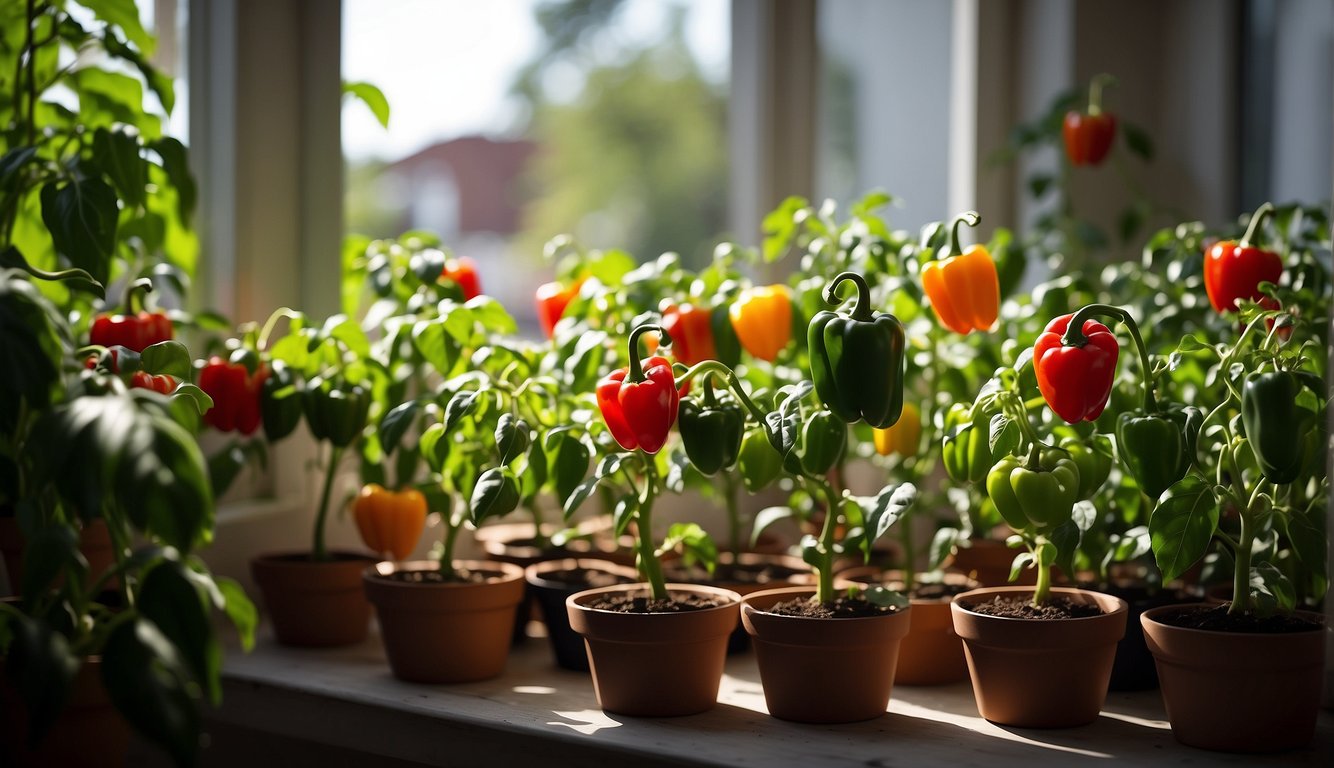TheHerbProf.com is a treasure trove of knowledge for those interested in natural healing and herbal remedies. The website is run by Paul Johnston MD. A naturopathic who has not only received extensive education in the field but also has personal experience in self-healing.
Yes, you can grow peppers indoors. Growing pepper plants indoors can be a fun and rewarding experience for any home gardener. Whether you want to grow them for ornamental purposes or to harvest fresh peppers, you can easily grow peppers indoors with a little bit of knowledge and patience.
Peppers are tropical plants that thrive in warm and humid environments. They require at least six hours of sunlight per day to grow and produce fruit, which can make growing them indoors a bit challenging. However, with the right growing conditions and equipment, you can successfully grow peppers indoors year-round. Keep reading to learn more about how to grow peppers indoors and what you need to get started.
Understanding Indoor Pepper Growing – Can You Grow Peppers Indoors?
Growing peppers indoors can be a fun and rewarding experience. Indoor pepper plants are a great way to enjoy fresh peppers all year round, even during the off-season. In this section, I will provide you with some basic information on how to grow peppers indoors.
Choosing the Right Pepper Varieties
When it comes to growing peppers indoors, it is important to choose the right variety. Some varieties, such as bell peppers, do not fruit as prolifically as smaller chili plants. Compact pepper varieties are generally better suited for indoor growing. Some popular varieties for indoor growing include Thai peppers, cayenne peppers, and jalapeños.
Setting Up the Growing Environment
Indoor pepper plants require a warm and humid environment to thrive. The ideal temperature for growing peppers is around 80 degrees Fahrenheit during the day and 70 degrees Fahrenheit at night. It is important to keep the temperature within a 20-degree range for optimal growth. A heating mat can help maintain the ideal temperature.
In addition to temperature, peppers also require a lot of light. Natural sunlight is the best source of light for indoor pepper plants. If natural sunlight is not available, grow lights can be used to supplement light. LED grow lights are a popular choice for indoor gardening.
Starting Pepper Seeds – Can You Grow Peppers Indoors?
Pepper seeds should be started indoors 8-10 weeks before the last frost date. Use a high-quality seed starting mix and plant the seeds ¼ inch deep. Keep the soil moist and warm until the seeds germinate. Once the seeds have germinated, thin them out to one plant per container.
Caring for Indoor Pepper Plants
Indoor pepper plants require regular watering and fertilization. Water the plants when the soil feels dry to the touch. Fertilize the plants once a month with a balanced fertilizer.
Indoor pepper plants also require pollination. Gently shake the plants or use a small paintbrush to transfer pollen from flower to flower.
Growing peppers indoors can be a fun and rewarding experience. By choosing the right variety, setting up the right environment, starting the seeds correctly, and caring for the plants properly, you can enjoy fresh peppers all year round.
Supplies Needed for Indoor Pepper Growing
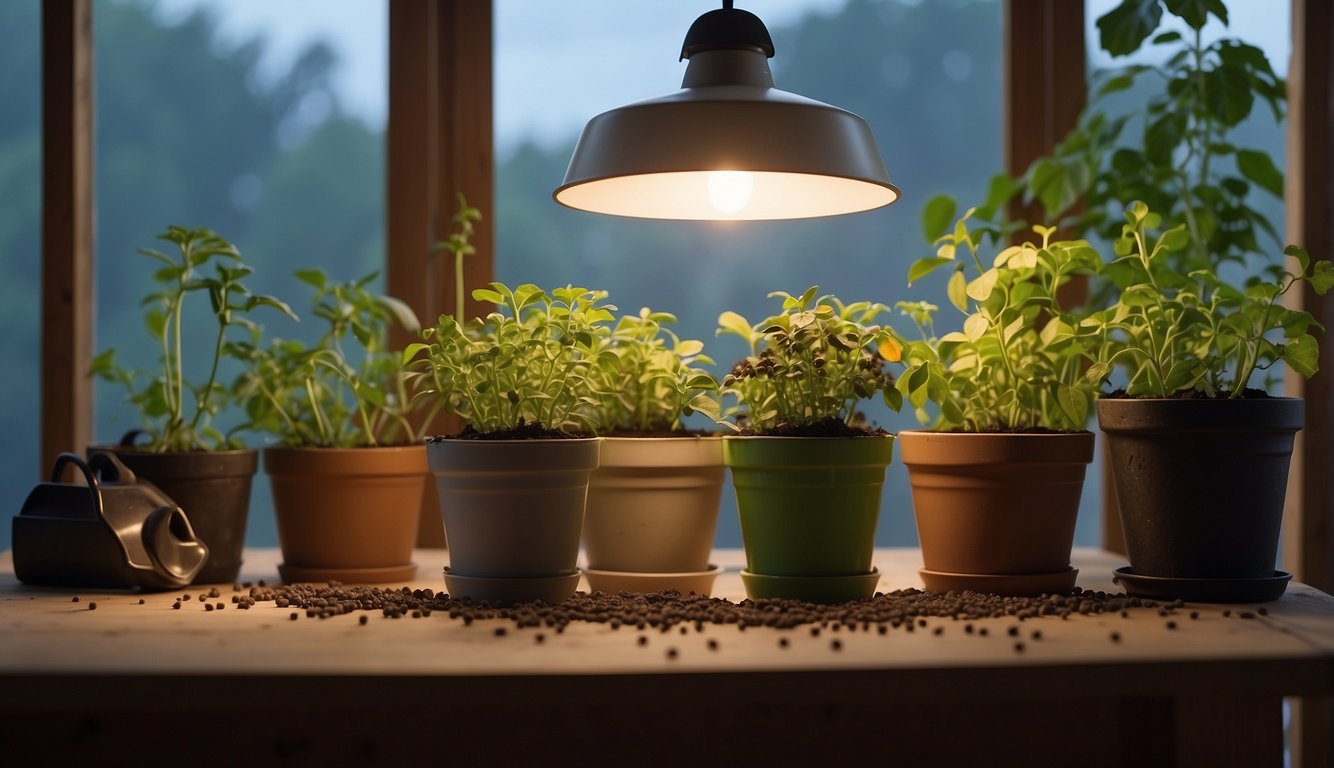
Growing peppers indoors requires a few supplies to ensure that your plants thrive. Here are the essential items you’ll need:
Container
Choose a container that is at least 10 inches deep and wide. A plastic plant pot or a well-draining planting tray works well. Ensure that the container has drainage holes to prevent waterlogging.
Grow Light – Can You Grow Peppers Indoors?
Peppers need at least 8 hours of full sun each day. If you don’t have access to a sunny windowsill, you’ll need a grow light. A supplemental light will help your plants grow and produce fruit.
Potting Mix
Use a well-draining soil mix that contains perlite or vermiculite. An organic potting mix is ideal, as it contains the necessary nutrients for healthy plant growth.
Heat Mat
Peppers need warm soil to germinate. A heat mat will keep the soil at a consistent temperature, which will help your seeds sprout quickly.
Seed Starting – Can You Grow Peppers Indoors?
You can start your pepper seeds in a seedling tray or a well-draining planting tray. Ensure that the seeds are planted at a depth of ¼ inch and water them lightly.
Humidity Dome
A humidity dome will help your seeds germinate quickly. It will also help to keep the soil moist, which is essential for healthy plant growth.
Full Sun – Can You Grow Peppers Indoors?
Peppers need full sun to grow and produce fruit. If you don’t have access to a sunny windowsill, you’ll need to place your plants under a grow light.
Mulch
Adding a layer of mulch to the top of your soil will help to retain moisture and keep the soil cool. Use a natural mulch, such as straw or shredded leaves.
In summary, growing peppers indoors requires a few essential supplies, including a container, grow light, potting mix, heat mat, seed starting tray, humidity dome, full sun, and mulch. With these supplies, you’ll be able to grow healthy and productive pepper plants in your home.
Pepper Variety Selection for Indoor Cultivation
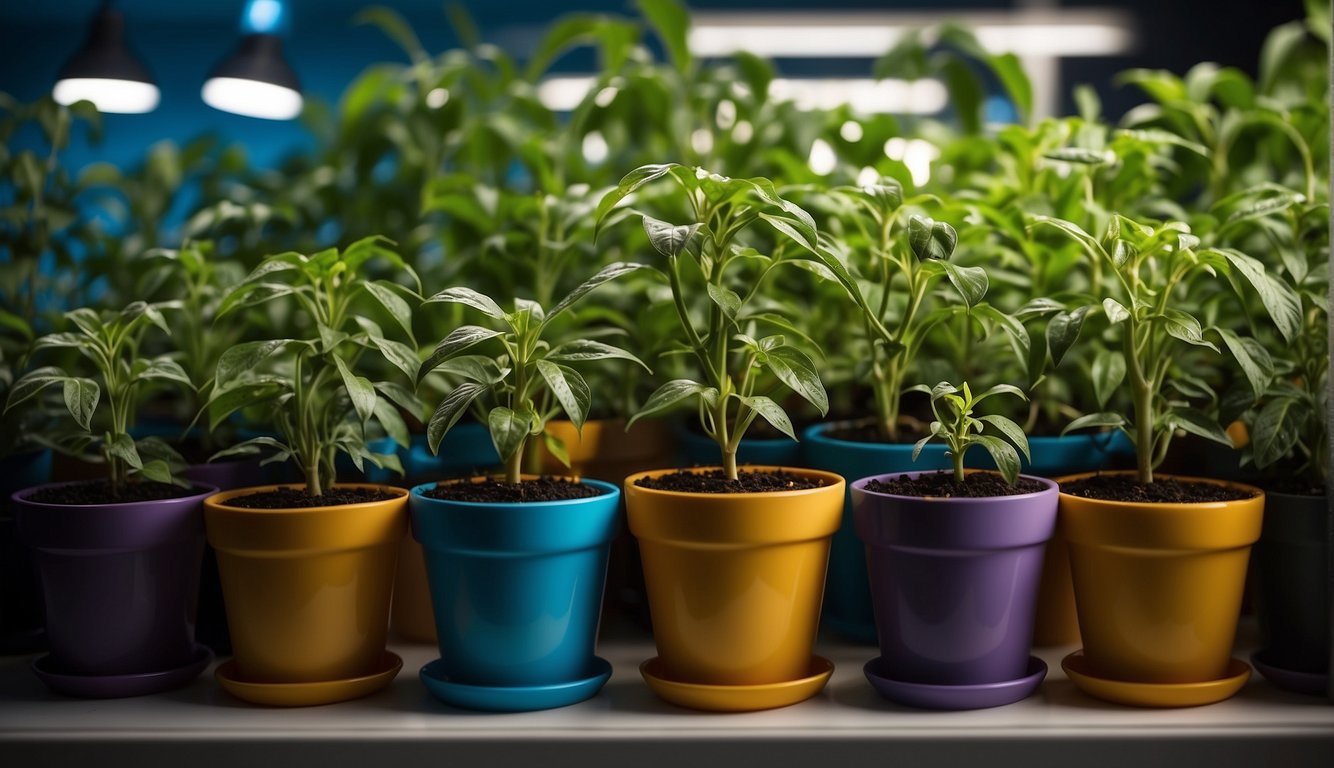
Growing peppers indoors is a great way to enjoy fresh, home-grown peppers year-round. However, not all pepper varieties are well-suited for indoor cultivation. In this section, I will discuss some good pepper varieties to grow indoors.
Good Pepper Varieties to Grow Indoors – Can You Grow Peppers Indoors?
When selecting pepper varieties for indoor cultivation, it is important to choose those that are compact and quick-maturing. Here are some good pepper varieties to consider:
- Pequin and Chiltepin: These are small, hot peppers that are well-suited for indoor cultivation. They are also ornamental and can add a touch of color to your indoor garden.
- Habaneros: These hot peppers are also a good choice for indoor cultivation. They are quick-maturing and produce peppers that are great for cooking.
- Thai Peppers: Thai peppers are another good choice for indoor cultivation. They are small and compact, and produce peppers that are great for adding spice to your dishes.
- Ornamental Peppers: If you are looking for a pepper variety that is both ornamental and edible, then ornamental peppers are a good choice. They come in a variety of colors and add a touch of beauty to your indoor garden.
When selecting pepper varieties for indoor cultivation, it is important to choose those that are well-suited for the indoor environment. Compact pepper varieties such as Pequins, Chiltepins, Habaneros, and Thai peppers are great choices. Additionally, ornamental peppers can add a touch of beauty to your indoor garden.
Starting Pepper Seeds Indoors – Can You Grow Peppers Indoors?
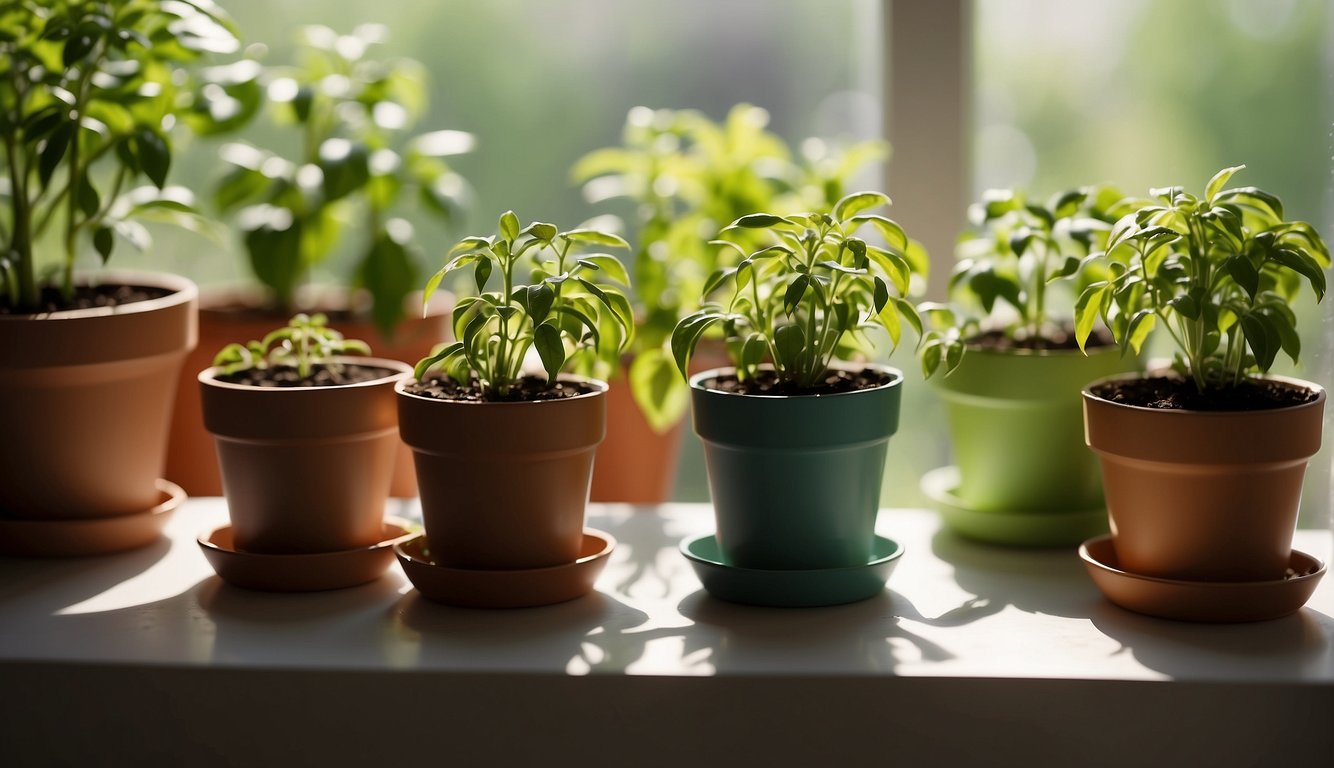
Growing peppers from seeds is a great way to ensure a bountiful harvest. Starting pepper seeds indoors gives you a head start on the growing season, and it’s a fun way to get your hands dirty in the winter months. Here are a few tips to help you get started:
Seeds
It’s important to start with fresh pepper seeds. Old seeds may not germinate, and even if they do, the resulting plants may be weak and stunted. If you’re not sure how old your seeds are, it’s best to buy new ones.
Germination – Can You Grow Peppers Indoors?
Pepper seeds need warmth and moisture to germinate. You can use a heat mat to provide the necessary warmth. It’s also important to keep the soil moist but not waterlogged. Overwatering can cause the seeds to rot.
Soil
Use a good quality seed-starting mix to give your pepper seeds the best chance of success. The soil should be loose and well-draining. Avoid using garden soil, which may contain weed seeds and pathogens.
Organic Fertilizer – Can You Grow Peppers Indoors?
Once the seeds have germinated and the seedlings have true leaves, it’s time to start fertilizing. Use an organic fertilizer to provide the nutrients your pepper plants need to grow strong and healthy.
Starting pepper seeds indoors is a great way to get a jump start on the growing season. With a little care and attention, you can grow healthy, productive pepper plants right in your own home.
Indoor Pepper Plant Care – Can You Grow Peppers Indoors?
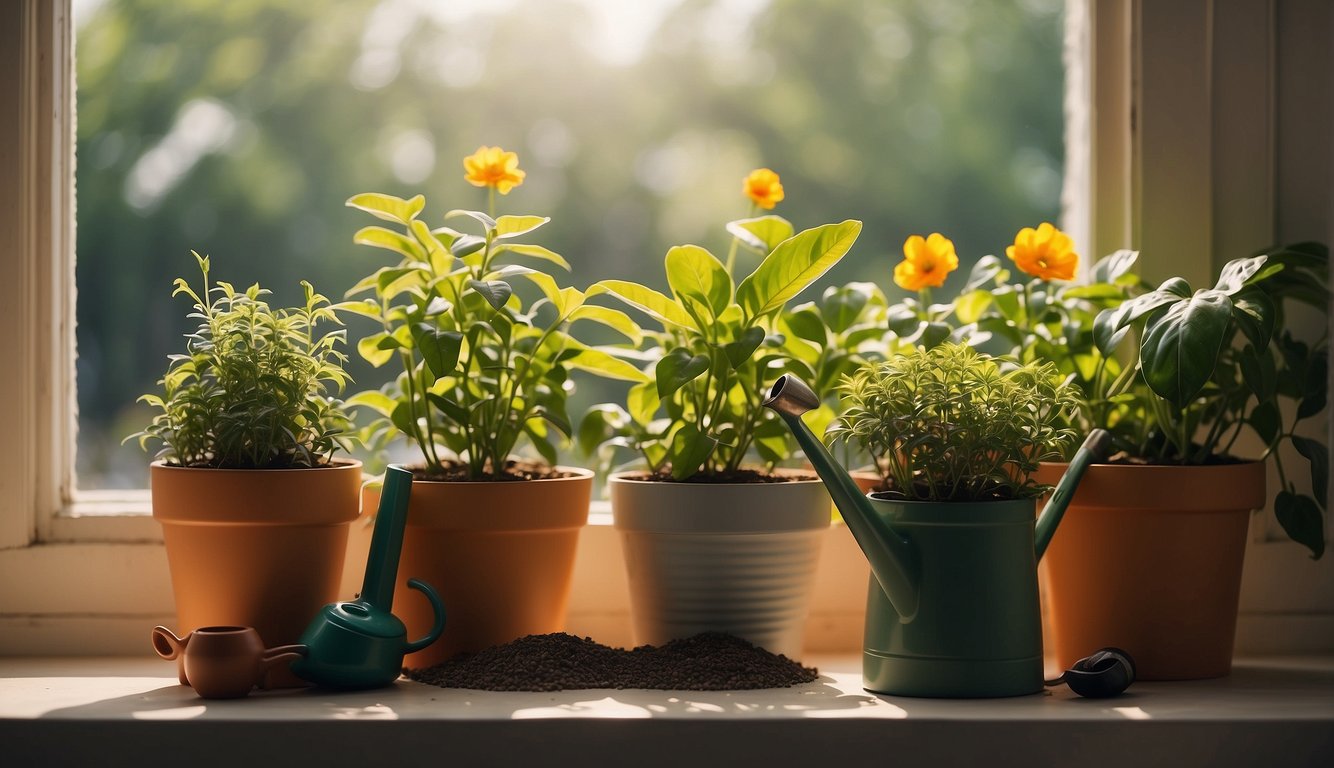
Growing peppers indoors can be a rewarding experience, but it requires some extra care and attention. In this section, I will discuss the temperature, fertilizer needs, humidity, and aeration considerations for indoor pepper plants.
Temperature for Growing Peppers
Indoor pepper plants require warm temperatures to thrive. The ideal temperatures for growing peppers are between 70-85°F during the day and 60-70°F at night. If the temperature drops below 60°F, it can cause the pepper plant to become stressed and may lead to stunted growth or even death. To maintain the proper temperature, you can use a heat mat or place the pepper plant near a heat source.
Indoor Fertilizer Needs
Indoor pepper plants require regular fertilization to grow and produce fruit. You can use a balanced fertilizer with equal amounts of nitrogen, phosphorus, and potassium. It is best to fertilize the pepper plant every two weeks during the growing season and reduce the frequency during the winter months. Be sure to follow the instructions on the fertilizer package and avoid over-fertilizing, which can lead to salt buildup and damage the root system.
Humidity and Aeration Considerations
Pepper plants require proper humidity levels to grow and produce fruit. The ideal humidity range for indoor pepper plants is between 40-60%. You can increase humidity levels by placing a tray of water near the pepper plant or using a humidifier. It is also important to provide adequate aeration to prevent mold and disease. You can achieve this by using a fan or opening a window for a few hours each day.
Growing peppers indoors can be a fun and rewarding experience if you provide the proper growing conditions. By following the guidelines for temperature, fertilizer, humidity, and aeration, you can enjoy a bountiful harvest of fresh peppers year-round.
Getting Indoor Peppers to Produce Fruit

As exciting as it is to grow peppers indoors, it can be frustrating when your plants are not producing fruit. Here are a few tips to help encourage fruiting in your indoor pepper plants.
Change Fertilizers
One reason your indoor pepper plants may not be producing fruit is due to the type of fertilizer you are using. While nitrogen-rich fertilizers can encourage lush foliage growth, they may not be providing the right nutrients for fruit production. Consider switching to a fertilizer with higher levels of phosphorus and potassium, which are essential for fruit development.
Encourage More Fruiting – Can You Grow Peppers Indoors?
Another way to encourage fruiting in your indoor pepper plants is to provide them with optimal growing conditions. Make sure your plants are receiving enough light, water, and nutrients. You can also try hand-pollinating your plants using a cotton swab or small brush. This can help ensure that the flowers are being pollinated, which is necessary for fruit production.
If you have a self-pollinating variety of pepper, you may not need to hand-pollinate your plants. However, it never hurts to give them a little extra help. Additionally, make sure to harvest your peppers regularly. Leaving peppers on the plant for too long can signal to the plant that it no longer needs to produce more fruit.
By following these tips, you can increase your chances of getting indoor peppers to produce fruit. Remember to be patient and give your plants the care they need to thrive.
Common Indoor Pepper Plant Problems
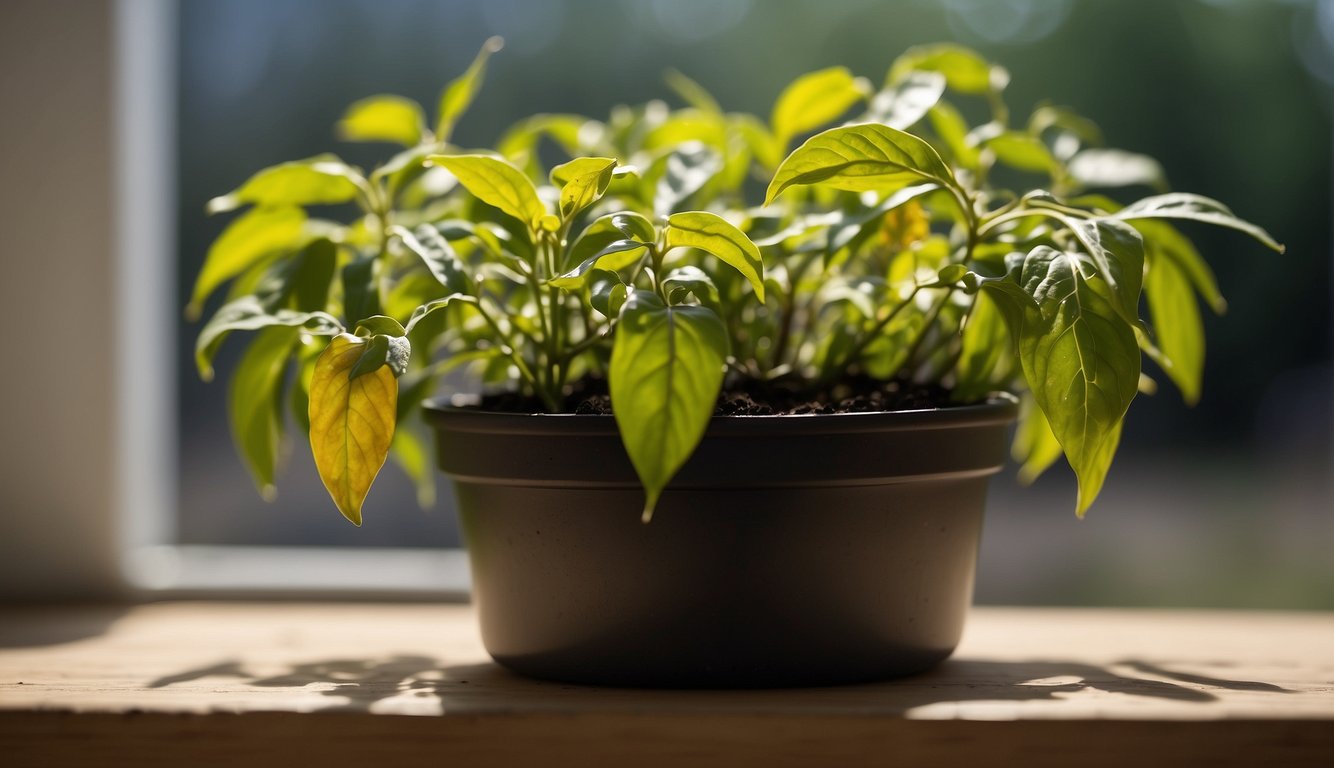
Growing peppers indoors can be a rewarding experience, but it is not without its challenges. Here are some common indoor pepper plant problems that you may encounter and how to deal with them.
Light Burn
One of the most common problems when growing peppers indoors is light burn. This occurs when the plants are exposed to too much direct sunlight or grow light. The leaves will turn yellow and brown and may even curl up. To prevent light burn, make sure your plants are not exposed to direct sunlight and adjust the height of your grow light to ensure that it is not too close to the plants. If you notice light burn, move your plants further away from the light source.
Pests and Diseases – Can You Grow Peppers Indoors?
Indoor pepper plants can be susceptible to pests and diseases, just like outdoor plants. Some common pests that can affect indoor pepper plants include aphids, spider mites, and whiteflies. To control pests, you can use neem oil or insecticidal soap. These organic plant pesticides are effective at controlling pests without harming your plants.
In addition to pests, indoor pepper plants can also be affected by diseases such as leaf spot and powdery mildew. To prevent these diseases, make sure your plants are not overcrowded and have good air circulation. If you notice signs of disease, remove the infected parts of the plant and dispose of them properly.
By being aware of these common indoor pepper plant problems and taking steps to prevent and control them, you can enjoy a healthy and thriving indoor pepper garden.
Bringing Peppers Indoors from Outside
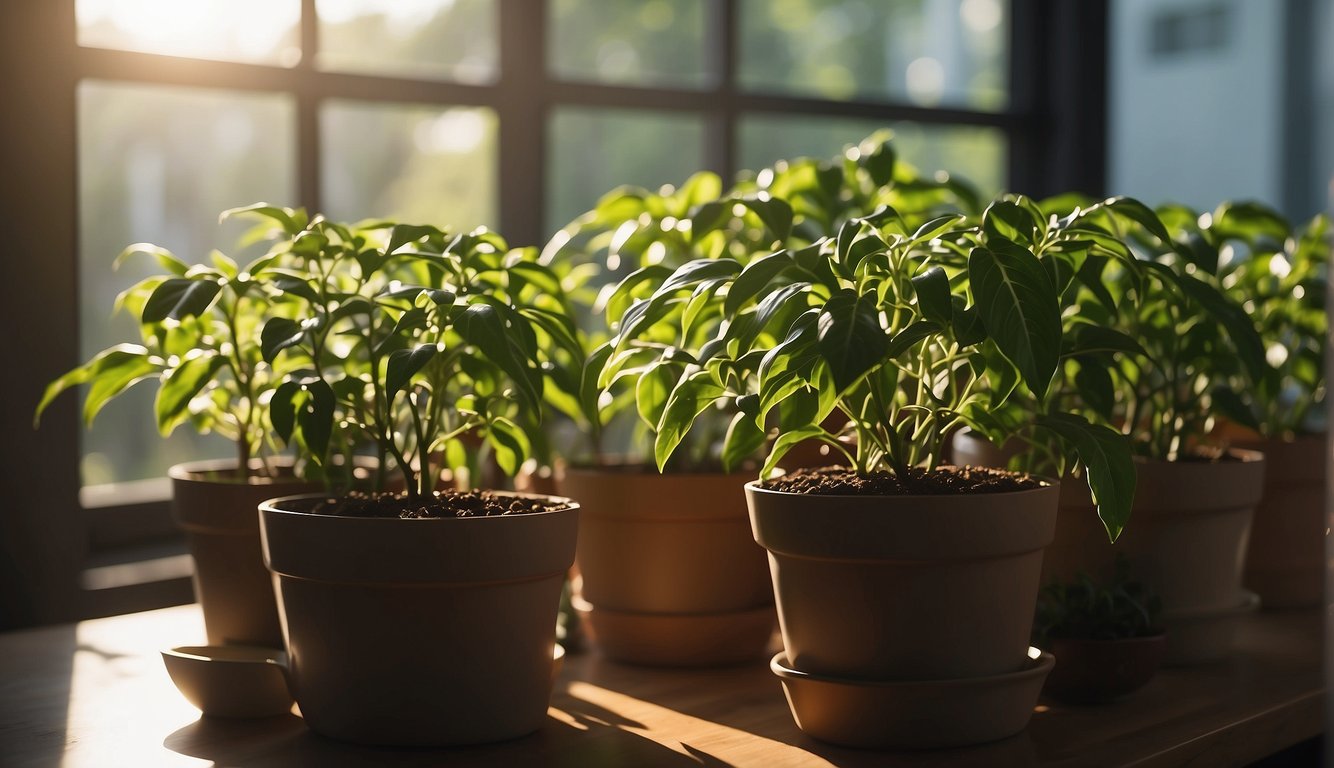
As an indoor gardener, I always try to maximize my yields by bringing my outdoor pepper plants inside during the colder months. This allows me to continue growing peppers throughout the year and enjoy fresh produce even in the winter.
Transplanting outdoor pepper plants to indoor pots requires some planning and preparation. First, choose a location in your home that gets plenty of sunlight and has a consistent temperature. Peppers need at least six hours of sunlight per day, so make sure the location you choose gets enough natural light. If natural light is not available, you can supplement with grow lights.
When transplanting, be sure to use a high-quality potting mix and a container that is at least 12 inches deep. This will give the roots enough room to grow and allow the plant to thrive. It’s also important to water the plant thoroughly after transplanting and to keep the soil moist but not waterlogged.
During the winter months, indoor environments can be dry, which can cause problems for your plants. To combat this, you can use a humidifier or place a tray of water near your plants to increase the humidity.
By bringing your outdoor pepper plants inside, you can continue to enjoy fresh peppers throughout the year. With proper planning and care, your plants can thrive and produce a bountiful harvest.
Before You Go – Can You Grow Peppers Indoors?
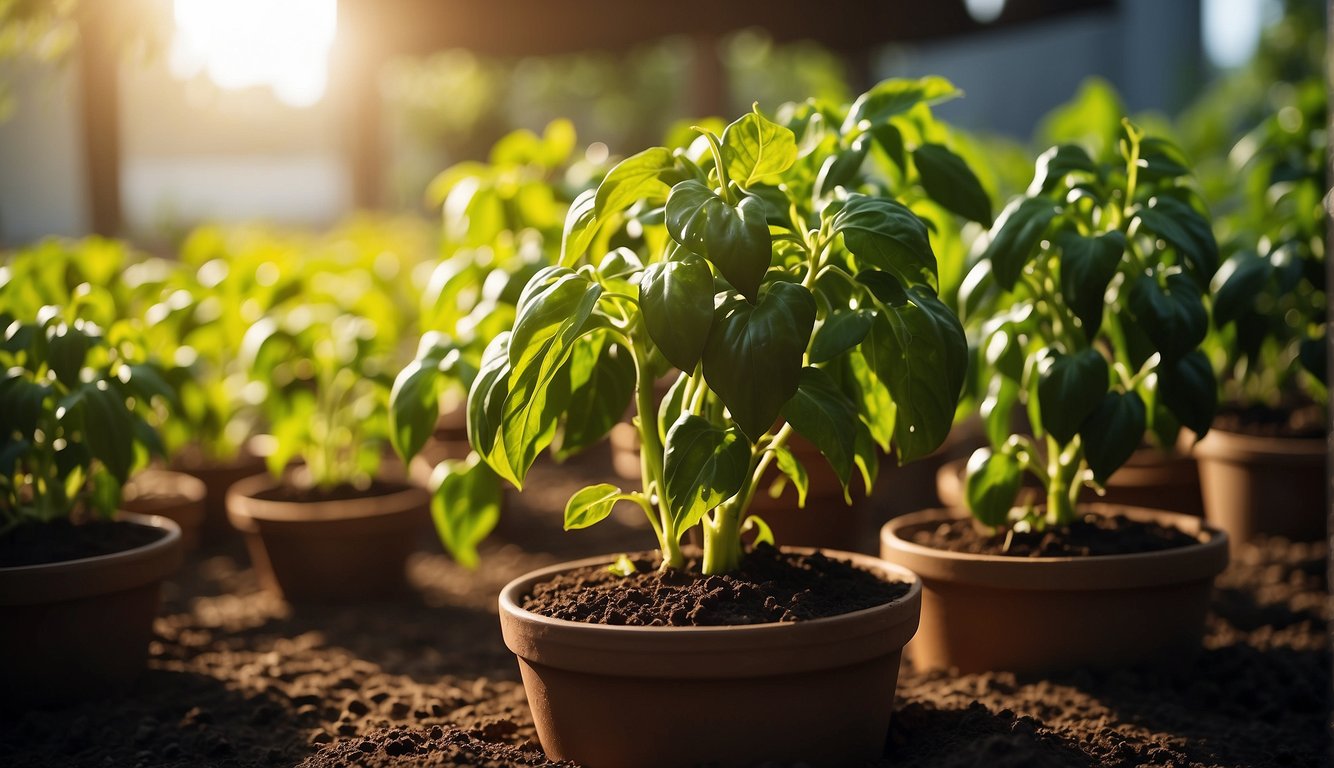
Growing peppers indoors is a great way to enjoy fresh peppers year-round. With the right supplies and techniques, anyone can successfully grow mature pepper plants indoors.
One important factor to consider when growing peppers indoors is providing plenty of light. As we discussed earlier, grow lights are essential for indoor pepper plants. You can also position your plants near a sunny window, but keep in mind that the amount of light they receive may not be sufficient for them to thrive.
Another important consideration is choosing the right variety of peppers to grow indoors. While most pepper varieties can be grown indoors, some are better suited for indoor growing than others. For example, smaller chili plants tend to fruit more prolifically than larger bell peppers.
If you’re new to indoor gardening, it’s also important to start small and work your way up. Begin with a few plants and gradually increase the number as you become more comfortable with the process. You can also sign up for gardening newsletters or download free guides to learn more about indoor gardening techniques.
Overall, growing peppers indoors can be a rewarding and enjoyable experience. With a little patience and attention to detail, you can grow delicious peppers right in your own home, regardless of the season.
Can You Grow Peppers Indoors: A Herbalist’s Insight
Hello, green thumbs! Today, we’re diving into a spicy topic – Can you grow peppers indoors? The answer is a resounding yes! You can grow a variety of peppers right in your home!
First off, let’s talk about why you’d want to grow peppers indoors. It’s simple – it’s a fantastic way to have fresh peppers on hand for your culinary creations! Plus, it’s a great way to bring a touch of greenery indoors.
Now, let’s tie this back to theherbprof.com. As your friendly neighborhood Herbalist Blogger, I’m all about helping you nurture your green thumb. And growing peppers indoors? It’s a perfect example!
By growing your own peppers, you’re not just adding spice to your meals. You’re also embracing the principles of indoor gardening, a topic I’m passionate about and often discuss on my blog, theherbprof.com.
References – Can You Grow Peppers Indoors?
Little Herb Encyclopedia, by Jack Ritchason; N.D., Woodland Publishing Incorporated, 1995
The Ultimate Healing System, Course Manual, Copyright 1985, Don Lepore
Planetary Herbology, Michael Tierra, C.A., N.D., Lotus Press, 1988
Handbook of Medicinal Herbs, by James A. Duke, Pub. CRP Second Edition 2007
The Complete Medicinal Herbal, by Penelope Ody, Published by Dorling Kindersley
Check the Following Articles!
Tomato Sprouting Inside: Causes and Solutions
Hydrogen Peroxide Soil Drench: Benefits and How to Use It
Growing Brussel Sprouts in Zone 7: Tips and Tricks
Frequently Asked Questions – Can You Grow Peppers Indoors?
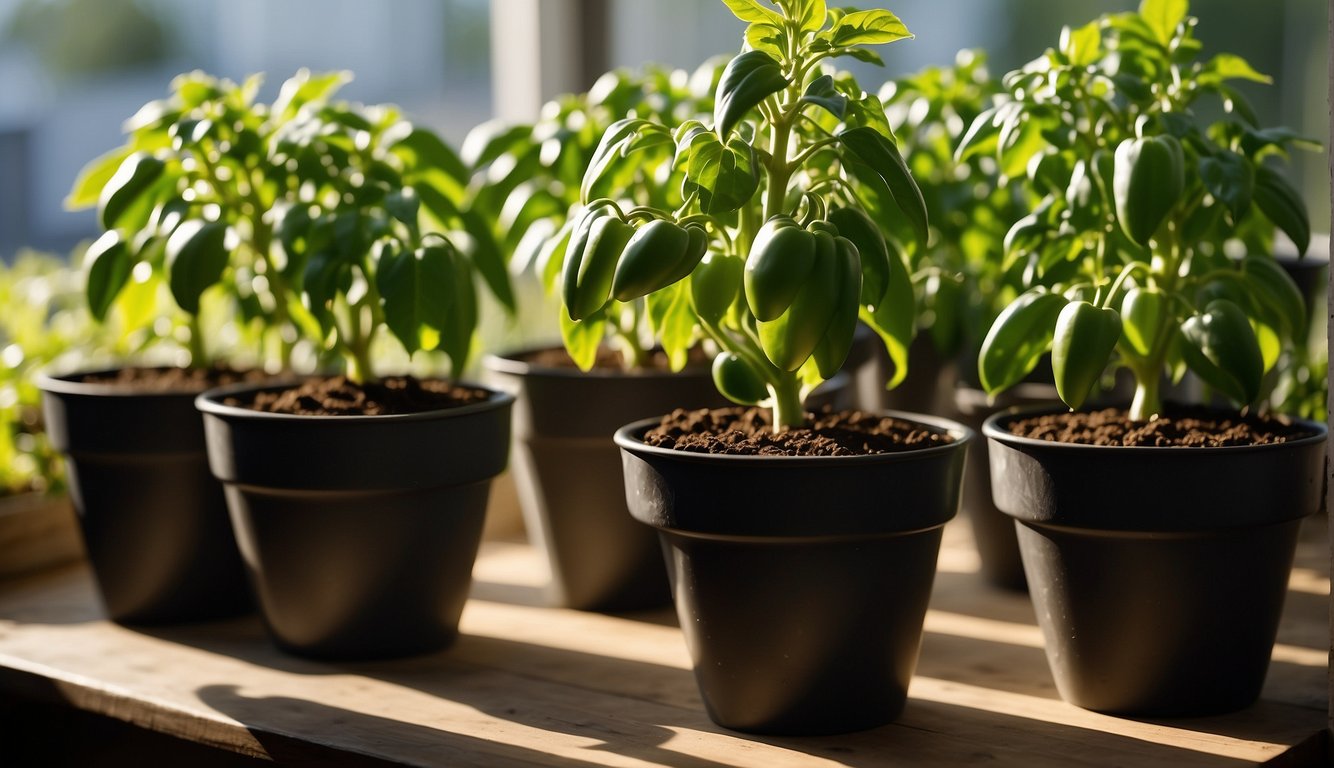
What are the best types of peppers to cultivate inside?
When it comes to growing peppers indoors, compact pepper varieties are the best choice. Bell peppers are a popular choice, but smaller chili plants tend to fruit more prolifically. Ornamental peppers are also an option, as they are often sold as indoor ornamentals.
Is it possible to grow peppers indoors using hydroponics?
Yes, it is possible to grow peppers indoors using hydroponics. In fact, hydroponic systems can be an efficient and effective way to grow peppers indoors. However, it is important to ensure that the plants receive the right amount of nutrients and water.
How do you successfully grow peppers from seeds indoors?
To successfully grow peppers from seeds indoors, you will need to start by selecting a good quality seed starting mix. Sow the seeds in the mix and keep them moist. Once the seeds have germinated, move the seedlings to a sunny spot or under grow lights. As the seedlings grow, transplant them to larger containers.
Can indoor pepper plants produce fruit throughout the entire year?
Yes, indoor pepper plants can produce fruit throughout the entire year, as long as they receive the right amount of light, nutrients, and water. However, it is important to note that the fruiting season may be shorter than that of outdoor plants.
What are the essentials for growing peppers indoors using grow lights?
The essentials for growing peppers indoors using grow lights include a good quality grow light, a timer, and a reflective surface to maximize light exposure. It is important to ensure that the plants receive the right amount of light, as too little or too much light can negatively impact growth.
How is pollination managed for indoor pepper plants?
Indoor pepper plants can be pollinated manually by using a small brush or cotton swab to transfer pollen from one flower to another. Alternatively, you can gently shake the plants to encourage pollination. It is also important to ensure that the plants receive proper air circulation to help with pollination.
